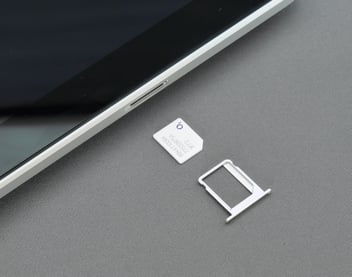

Understanding eUICC vs eSIM: Key Differences Explained
You would be forgiven for thinking that eUICC and eSIM are the same thing, given that they are being used interchangeably by a lot of media sites and blogs. However, that they are two different technologies.
In this article, we will clearly define what eSIM and eUICC truly are and discuss some of the distinct advantages they provide.
So, what exactly does eSIM mean?
SIM stands for Subscriber Identity Module and is often used to refer to the small card-shaped chip that is inserted into smartphones and other mobile-connected devices. The SIM enables a device to be recognized on the carrier network and identified by the number associated with it.
Traditional SIM cards have been evolved significantly over time. It’s hard to imagine now, but the first SIM actually resembled a credit card in size and weight! This is known as the first form factor of SIM, or 1FF.
Subsequent forms of SIM include the mini-SIM (second form factor, or 2FF), micro-SIM (3FF) and the nano-SIM (4FF).
There is now also another SIM form factor, the MFF2, which consists of embedded SIMs soldered onto the device circuit board. This is the preferred form factor for connected devices that operate harsh conditions.

Confusion arises when people assume that an embedded SIM (MFF2) has remote provisioning capabilities (eUICC) because both MFF2 and eUICC are referred to as eSIM. So which one is eSIM?
To avoid confusion, we suggest the following definition:
"eSIM is the whole service − SIM + eUICC + platform;
eUICC is the software that allows provisioning."
According to the GSMA (GSM Association), eSIM refers to the overall service that includes the SIM hardware, the eUICC software, and the platform that enables remote provisioning and management of network profiles. On the other hand, eUICC specifically refers to the software component that allows for the remote provisioning and management of these profiles. This distinction is crucial to avoid confusion, especially since both terms are often used interchangeably in the media and by some businesses.
In fact, eSIM is a technology that can be present regardless of form factor. For example, the iPhone XR accommodates a removable SIM but also has an eSIM service built-in, allowing users to purchase a plan from another carrier and use it alongside their contracted calls, messaging and data plan.
In summary, eUICC is the software enabling a SIM to remotely provision mobile network operators, whereas eSIM represents the entire service ecosystem. Both are independent of the MFF2 form factor.
What does eUICC do that a UICC can’t?
To better understand eUICC, it can be useful to compare it with its predecessor, highlighting the differences between eUICC and eSIM.
The Universal Integrated Circuit Card (UICC) does more than just the Subscriber Identity Module (SIM). It runs the SIM application whilst also storing various pieces of information such as the user’s contacts list, enabling the use of mobile data and managing data roaming across multiple carriers.
What is the difference between UICC and eUICC?
eUICC, or Embedded Universal Integrated Circuit Card, often leads to confusion with the embedded SIM MFF2 among businesses. However, eUICC is actually a SIM component that can be integrated into any SIM form factor to facilitate the eSIM service, including embedded options.
A key advantage of an eUICC-enabled SIM card is its capability to conduct over-the-air (OTA) provisioning of various network operator profiles from a centralised management hub. After provisioning, the SIM profiles on the card can be managed remotely and deleted if required.
Over-the-air provisioning and management provide a degree of flexibility that was unattainable before the advent of eUICC. Devices equipped with an eSIM service can be transitioned in large numbers almost instantaneously, and we are merely at the beginning of this technology's evolution.
What does Velos IoT offer? 
Velos IoT provides eSIM solutions crafted to unlock the full potential of your business.
Our ULTIMATeSIM solution delivers reliable, seamless, and secure global connectivity. Tailored for IoT service providers, OEMs, and large enterprises, it empowers their services and devices to function worldwide.
By harnessing top-tier coverage from leading carrier networks, ULTIMATeSIM facilitates both global and local connectivity across diverse SIM form factors and industrial standards.
To learn more about eSIM for IoT, check out our quick guide to everything you need to know about eSIM for IoT.
Interested in learning more about Velos IoT eSIM solution and test it out? Request an ULTIMATeSIM free starter kit today.
Speak to a Velos IoT expert
Related articles


What is eUICC and how does it impact the future of connectivity
eUICC is being hailed as the next evolutionary step for mobile connectivity. It has been generating...

Why iSIM is the future of IoT Connectivity
In the rapidly evolving landscape of Internet of Things (IoT) connectivity, the emergence of...

